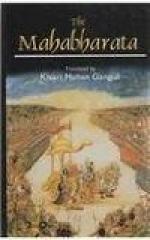SECTION LXXXIII
“Vaisampayana said, ’Worshipped by the ruler of Magadha, Pandu’s son having white steeds yoked unto his car, proceeded along the south, following the (sacrificial) steed. Turning round in course of his wanderings at will, the mighty steed came upon the beautiful city of the Chedis called after the oyster.[199] Sarabha, the son of Sisupala, endued with great strength, first encountered Arjuna in battle and then worshipped him with due honours. Worshipped by him, O king, that best of steeds then proceeded to the realms of the Kasis, the Angas, the Kosalas, the Kiratas, and the Tanganas. Receiving due honours in all those realms, Dhananjaya turned his course. Indeed, the son of Kunti then proceeded to the country of the Dasarnas. The ruler of that people was Chitrangada who was endued with great strength and was a crusher of foes. Between him and Vijaya occurred a battle exceedingly terrible. Bringing him under his sway the diadem-decked Arjuna, that foremost of men, proceeded to the dominions of the Nishada king, viz., the son of Ekalavya. The soon of Ekalavya received Arjuna in battle. The encounter that took place between the Kuru hero and the Nishadas was so furious as to make the hair stand on end. Unvanquished in battle, the valiant son of Kunti defeated the Nishada king who proved an obstacle to the sacrifice. Having subjugated the son of Ekalavya, O king, the son of Indra, duly worshipped by the Nishadas, then proceeded towards the southern ocean. In those regions battle took place between the diadem-decked hero and the Dravidas and Andhras and the fierce Mahishakas and the hillmen of Kolwa. Subjugating those tribes without having to accomplish any fierce feats, Arjuna proceeded to the country of the Surashtras, his footsteps guided by the horse. Arrived at Gokarna, he repaired thence to Prabhasa. Next he proceeded to the beautiful city of Dwaravati protected by the heroes of the Vrishni race. When the beautiful sacrificial horse of the Kuru king reached Dwaravati, the Yadava youths, used force against that foremost of steeds. King Ugrasena, however, soon went out and forbade those youths from doing what they meditated. Then the ruler of the Vrishnis and the Andhakas, issuing out of his palace, with Vasudeva, the maternal uncle of Arjuna, in his company, cheerfully met the Kuru hero and received him with due rites. The two elderly chiefs honoured Arjuna duly. Obtaining their permission, the Kuru prince then proceeded to where the horse he followed, led him. The sacrificial steed then proceeded along the coast of the western ocean and at last reached the country of the five waters which swelled with population and prosperity. Thence, O king, the steed proceeded to the country of Gandharas. Arrived there, it wandered at will, followed by the son of Kunti. Then occurred a fierce battle between the diadem-decked hero and the ruler of Gandharas, viz., the son of Sakuni, who had a bitter rememberance of the grudge his sire bore to the Pandavas.’




